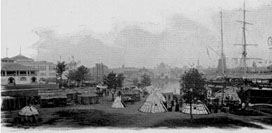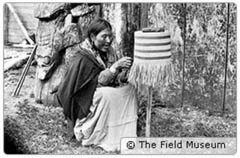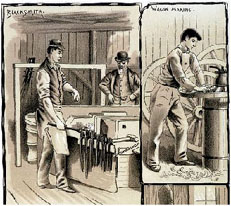So
we have three competing discourses in tension
with one another emerging from the Columbian Exposition of
1893. Despite their differences,
each of them are racializing discourses because they essentialize
Native American people and cultures—less complex, less
developed, and less human than Euro-Americans:
1.
The scientific discourse of social evolutionism positioned
American Indians as living in “primitive” societies—picturesque
and curious but doomed to extinction according to evolutionary
principles. |
|
|
2.
The assimilationist discourse of the Bureau
of Indian Affairs and Christian reformers stated that Native
American cultures
made it impossible for them to “progress” and
become good American citizens. While denigrating Native cultures,
this discourse promoted the idea that American Indians could
integrate into American society by developing the “proper” civilized
attitudes toward work, education, and citizenship. |
3.
The mythologizing “heroic warriors of a vanishing
culture” discourse promoted
by Buffalo Bill’s Wild West Show generated
enduring imagery that captured the imagination of the American
public. Although portrayed heroically and sympathetically,
the narrative was just as racializing because it too anticipated
the “vanishing Indian.” It also entrenched
in the American popular imagination a powerful set of romanticized
images that all Native people were expected to fit into,
or risk being denounced as not “real.” |
|
Continue
to Page 7
Back
to Page 5
|





